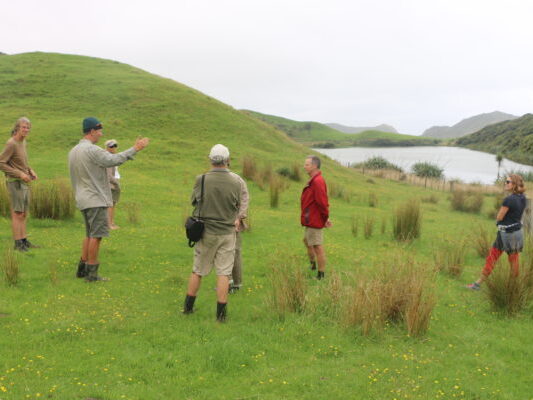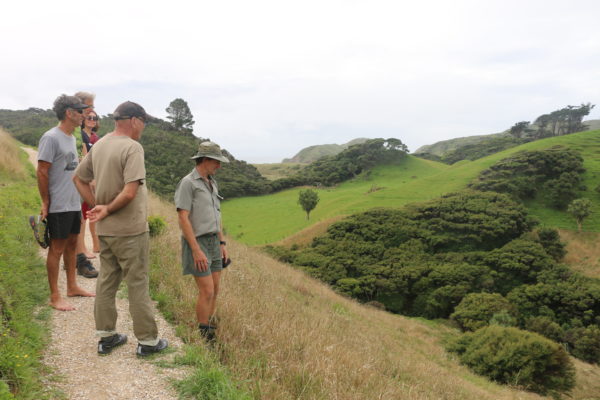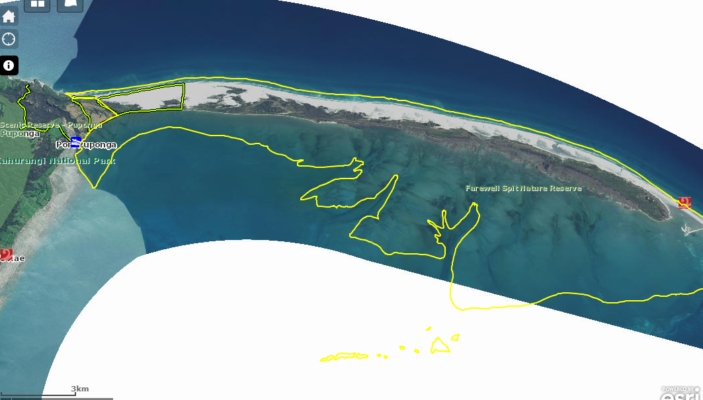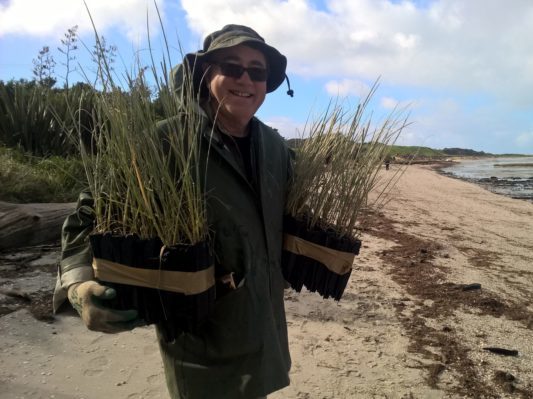The first time that 80 double-trap DOC 200s were set out at the Wharariki Onetahua Restoration site they caught 29 rats and 25 stoats! Some traps caught two predators!
Catching 25 stoats off 80 traps is an awesome total – but think about what that says about the sheer army of predators that wildlife at Wharariki Beach, near Farewell Spit, were facing. The traps have continued to catch both rats and stoats in the 12 months since they were first set out.

“Stoat catch numbers went down for a while,” says Peter Butler, Director of NZ’s largest online retailer of natural health and skincare products, HealthPost, “but the recent January trap clearing found 16 stoats and a weasel, along with numerous rats.”
HealthPost is based in nearby Collingwood and is the key instigator and funder of the Wharariki Onetahua Restoration through Farewell Wharariki HealthPost Nature Trust .
The initial phase of the project focusses on the 900-hectare area at the base of Farewell Spit, from Wharariki Beach on the north-west coast to Puponga and Triangle Flat on the western side of Golden Bay. The cliffs of Cape Farewell are the most northerly point of the South Island, and they and the nearby iconic Archway Islands are vital to a range of seabirds and other species.
“It’s a wonderful place,” says Peter, “but riddled with predators, even though it’s a Ramsar site (wetland of international importance). The ornithologists are not too concerned,” he explains, “because although 10% of New Zealand’s wading birds feed there, most nest in Siberia. But pre-human times, with the deep Tasman on one side and sheltered Golden Bay on the other, we think it would have been a great breeding site for all kinds of birds.”

The area is well known for its birdlife, with more than 90 bird species living in its diverse habitats that include salt marshes, mudflats and sand dunes. But some of the other endemic native species that live there are a little less conspicuous.
“Katipo spiders live on the beach,” Peter confirms, “but wild pigs upend the driftwood where the katipo like to rest. And the rare Nelson green gecko is out there too.”
Peter was returning from a business trip to Auckland, flying into Nelson when he first felt inspired to start a restoration project at Farewell Spit.
“I looked down at the curve of the Spit in the glistening sea and it looked beautiful! I thought, ‘we could put a fence across and protect everything’,” he says. “That was naïve, but it started my conversation with DOC.”
Charity funding was already a key part of HealthPost’s business philosophy, through their ‘Better World’ donation programme.

“We have a scheme where we donate $1 to the charity of a customer’s choice whenever they buy a product,” Peter explains. “We’ve donated over $1 million so far to 40 different charities. But I thought ‘what about a local, long-term project that our staff could directly relate to?’ We’re Golden Bay’s largest employer with about 80 local staff and every year we have a staff planting day where we plant 1000 native trees. By focusing our planting around Farewell Spit we could come back each year and see how our reforestation was progressing.”
So Peter got in touch with the Department of Conservation.
“When Peter walked in the door and offered to fund conservation work in the area we were overjoyed!” says DOC Partnerships Ranger, Cornelia Vervoorn. “Farewell Spit and Puponga Farm Park have some outstanding ecosystems and incredible scenery. They also come with plenty of challenges for DOC when it comes to managing them.”
DOC had already been working away at reducing the infestation of weeds and pigs on the area.
“When conditions are right, we are able to do some landscape scale pest control,” Cornelia says.
The next step was to determine what the joint project would entail.
“There were so many opportunities to really enhance the ecological integrity of the area that choosing the best investment for the Trust to pursue took quite a bit of discussion,” says Cornelia.
“DOC were keen and the conversation went really well,” Peter says. “We signed a Memorandum of Understanding with Kay Booth, Deputy Director-General, Partnerships in August 2017.”
Together the two organisations have come up with a Joint Vision Statement of the goals for their partnership project.
HealthPost and DOC share a vision of creating a wondrous, accessible nature sanctuary at Farewell Spit. We will enable native species to flourish by controlling predators and re-establishing rare and threatened species. It will be a place for people to experience this unique landform as a thriving and diverse ecosystem.
“In the first year we planted 1000 trees along Wharariki stream,” says Peter. “The 80 traps run behind Wharariki beach right up to Pillar Point. It takes our action man, Grant, two days to clear them. The idea is to provide a trap barrier between the forest to the east and the cliffs and nesting spots on the western coastline. There’s a location around Wharariki Beach where some remnant shearwaters nest that we trap heavily and monitor with a wildlife camera. This little colony is evidence that the birds can nest back on the mainland, if they are given half a chance.”
Peter has found there is something of a ‘science vacuum’ on what flora and fauna could thrive if the Wharariki Onetahua Restoration is successful in eliminating the worst predators. Trustee Craig Potton is organising a ‘BioBlitz’ for the spring of 2019 which will bring together experts and support teams to try and identify the biggest conservation opportunities in the area so these can be prioritised.

“We’ve already commissioned national expert Tamsin Ward-Smith to do a survey of the coast to identify the best places is to establish a protected area where seabirds can establish a whole ecosystem on the mainland. We want to form a nucleus population. We’ve got sound recorders to record the passing seabirds and we’ll replay the recordings to lure birds in,” Peter says.
“We’re really happy that the Trust has chosen to focus on bringing seabirds and their associated ecology back to mainland New Zealand, and enhancing the ecological integrity of the area with intensive predator trapping and tree planting,” says Cornelia. “We’re really excited to see how the project develops over the next few years, and look forward to working with the Trust to really make a difference to this area.”
The landscape and geology of the area offers some promising opportunities.
“The outcrop at Cape Farewell has a narrow neck and is surrounded by very sheer cliffs,” says Peter. “According to Tamsin it’s a good take-off and landing site for seabirds and a short predator proof fence costing around $90,000 would protect 2.2 hectares.”
A final decision about the fence project and nesting site will be made later this month when Farewell Wharariki HealthPost Nature trustees meet with DOC, fence-builders and consultants, local Iwi and Tamsin.
“Our main objective at the moment is the Cape Farewell predator-proof fence,” Peter confirms. “The economies of long fences are being questioned, but in this situation a cut-off fence only needs to be about 100 metres long. In the future if ZIP’s experimental low fences prove predator-proof we may get more ambitious. The 10,000 hectares of Farewell Spit (when the tide is out) has sea protection on both sides and a narrow neck. And accessibility for the public is enshrined in our Joint Vision Statement with DOC.”
The katipo spiders hiding out in the driftwood haven’t been forgotten either.
“Last year the World Wide Fund for Nature (WWF, formerly the World Wildlife Fund) paid for an experiment where we commissioned a helicopter with thermal detectors to locate and shoot the feral pigs on Farewell Spit,” says Peter. “We hoped for 100% elimination but some surviving pigs were detected a few weeks later, so DOC will continue use ground control to keep those in check. Apart from upsetting katipo, pigs could destroy the gannet colony at the tip of the Spit. We will also be planting at least 1000 more trees this winter.”
The first priority for the restoration planting part of the project is to establish shelter.
“The plants are all locally sourced,” says Peter. “Wharariki beach is very popular with tourists, so I’d like to create a ‘sexy forest’ on the part of the path we’re planting out. People love the nikau and rata forest on the Heaphy Track and it would be good to establish something similar, among shelter plants like sand kanuka.”
Different areas suit different types of planting.
“There are iconic cabbage trees at the base of the spit but they’re being hit by cattle,” Peter says. “There’s a slip area where we will plant cabbage trees and toitoi. I’d like to do rare and threatened plants as well, like celery pine and the ‘bellbird tree’, the kaikomako. Bellbirds go nuts for it but its hit by possums so it’s a bit of a rarity.”
HealthPost formed its Nature Trust to manage the project and photographer/publisher Craig Potton and Stuart Macintosh, General Manager of Pics Peanut Butter and trustee of Motuihe Island Sanctuary are also Trustees, in addition to Dr Lucy Butler and Dr Chris Wheatley. Kim Hill recently agreed to become the Trust’s Patron. Peter, who is chair of the Trust, sees the project as a long-term one and has committed to a minimum of 5 years supporting the project at up to $100,000 per year. That’s quite a commitment.
“HealthPost believes the health of the individual is intrinsically tied to the health of the wider community and the environment,” says Peter. “People are not islands and good health is not just about taking a Vitamin C tablet.”
Peter is full of praise for the good working relationship that’s been formed with DOC.
“The Golden Bay DOC team are very proactive,” he says. “They’re quite gungho and prepared to back non-straightforward things, like the takahe release in Kahurangi. The Trust won’t pay for any poisoning of animals though, as this goes against the ethics of some of our staff and customers.”
He is also very keen to see other philanthropic organisations and funders get involved.
“We’re hoping that other partners might get involved, not just HealthPost,” he says. “At the moment we’re the leading donor, but in the bigger picture, the project is not HealthPost’s ‘baby’. We’re limited in what we can do with our annual budget and there are specific things like seabird translocation or wetlands restoration that other parties could get involved in.”
“Wharariki has a near complete watershed ecosystem,” says Peter. “The swamp was never properly drained. It’s a big wetlands with the stream we are planting, leading down to the sea. This whole tip of the South Island is magnificent. It’s a privilege to be contributing to its restoration,” he says.
Such an iconic part of New Zealand, popular with migrating wildlife, international tourists and kiwi holidaymakers, surely deserves all the support it can get.

